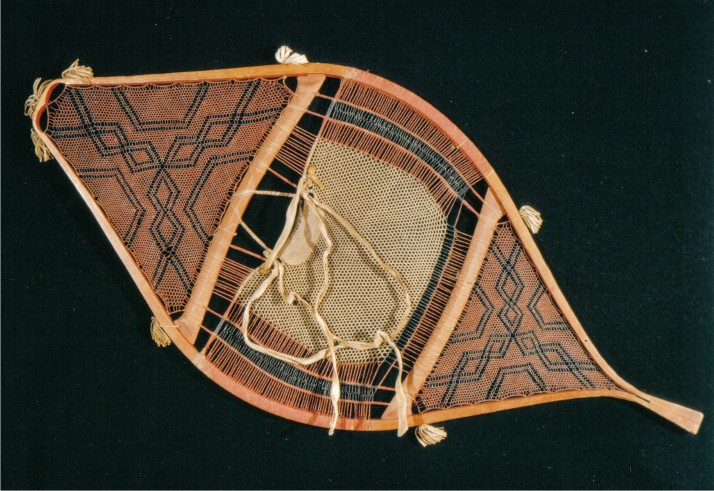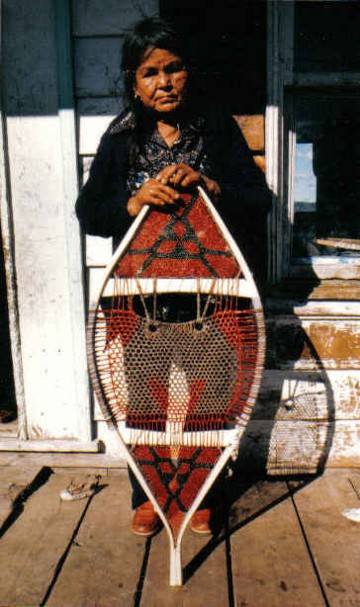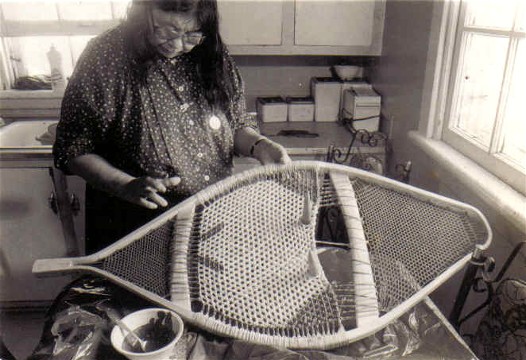|
|
|
Old Attikamek snowshoe ; circa early 1900's |
| Delicate grace and
meticulous workmanship, combined in a harmonious blend of function and art
make the Attikamek snowshoe one of the finest examples of handmade Indian
snowshoes in North America. "MAKING THE ATTIKAMEK SNOWSHOE'' describes the design, construction, and use of this highly evolved Native American implement.Discussed are the various modifications of the basic''square - toe'' snowshoe style and their effect on performance -- the selection and preparation of timber stock -- tool manufacture and use --frame assembly -- skin preparation -- plain and fancy snowshoe weaving -- snowshoe decoration--and Native harnesses and footgear. 176 pages, 130 illustrations, 255 photos |
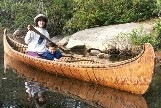 |
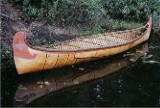 |
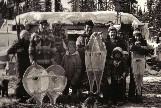 |
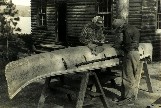 |
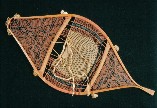 |
| Full size birchbark canoes | Scale model birchbark canoes | Native technology videos and DVDs | Native technology books | |
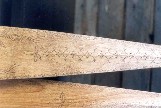 |
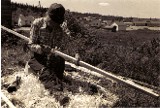 |
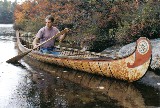 |
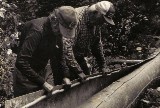 |
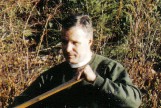 |
| Traditional paddles | Crooked knives | Home |
Materials |
About the builder |
|
read more about :
''MAKING THE ATTIKAMEK SNOWSHOE'' |
|
|
While Indian snowshoe making was
highly developed throughout all of northern Canada and the US , it reached
it's peak of refinement in eastern Canada and Maine, where the snowshoe
transcended the merely utilitarian to become fine art .In these regions,
the men displayed their skill and aesthetic sensibilties in the fashioning
of the snowshoe frames , where the wood staves were often bent into
fanciful shapes , making them pleasing to the eye without diminishing
their functionality. To the south , the front of the snowshoe was often
bent in the ''square toe '' pattern and , in some areas , further hollowed
along the sides to enhance the overall effect ; farther north ,snowshoe
tails were given the rounded or squarish forms known as the ''
beavertail'' style. The making of these more elaborate frames required
additional labor , and consequently greater care was expended in their
weaving , as the most complex woven designs can be seen in these snowshoes
; here the women expressed their talent by incorporating beautiful
geometric patterns in a mesh that was sometimes so closely woven that a
matchstick would not pass through. While MAKING THE ATTIKAMEK SNOWSHOE was not written in a ''how -to '' style , it was meant to provide an aspiring craftsman the detailed information needed to reproduce the fine work of earlier generations while serving ,as much as possible, the broader scope of ethnology. |
| Elisabeth Flamand with the finished snowshoe painted with traditional powdered pigments ; the end sections are painted solid red and the midsection is outlined in red according to a traditional pattern ; Manouane , Quebec , 1983 ; from ''Making the Attikamek Snowshoe'', photo Henri Vaillancourt | |
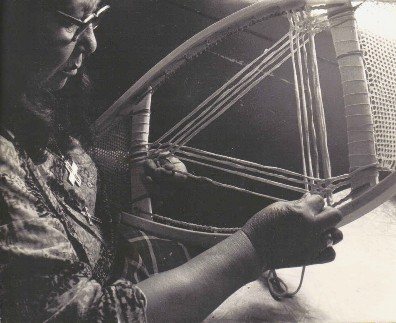 |
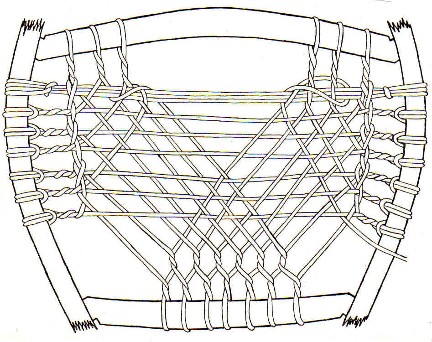 |
| Elisabeth Flamand weaving the mid-section of a pair of square-toe snowshoes ; Manoune , Quebec 1979 ; photo Henri Vaillancourt | Weaving the mid-section of an Attikamek snowshoe ; the extra space at the tail crossbar is a decorative feature peculiar to the Attikamek ; from ''Making the Attikamek Snowshoe''; sketch , Henri Vaillancourt |
''MAKING THE ATTIKAMEK
SNOWSHOE'' describes in detail the making of different styles of snowshoe
as practiced by several elderly Attikamek Indians in the 1970's and 80's.
A partial list of topics covered include :
|
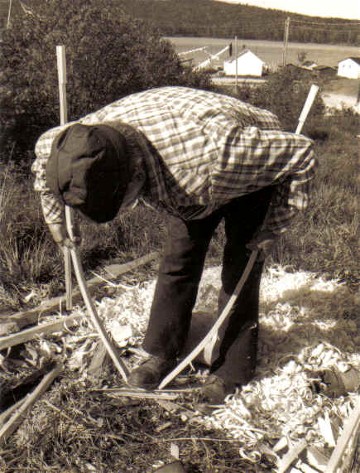 |
|
Moise Flamand pulling a square-toe snowshoe frame into shape; Manouane, Quebec 1979; from ''Making the Attikamek Snowshoe '', photo Henri Vaillancourt |
|
|
|
| Elizabeth working on painted snowshoe |
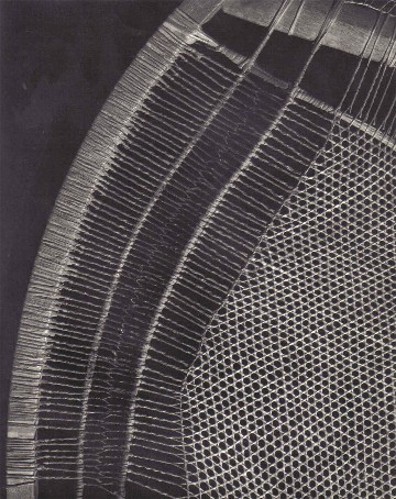 |
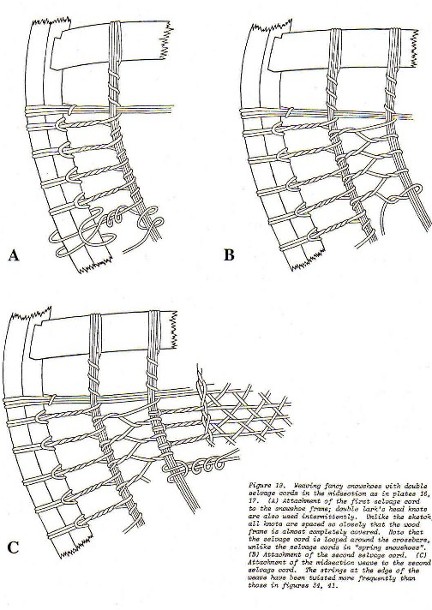 |
|
| The decorative double selvage cords in the mid-section of an old pair of fancy snowshoes,;circa early 1900's . Double selvage cords were once a fairly common feature of the more highly finished Attikamek snowshoes ; they create distinctive bands of separation between the actual woven part of the mesh and the snowshoe frame....when combined with the double space at the rear crossbar , the woven mesh appears to float in the frame , giving the snowshoes a light and delicate appearence; from ''Making the Attikamek Snowshoe'', photo courtesy of lower Ft. Garry National Historic Park | Installing the double selvage cords in a pair of fancy snowshoes; from ''Making the Attikamek Snowshoe'', sketch Henri Vaillancourt |
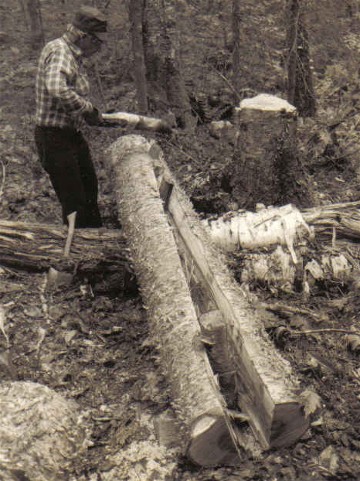 |
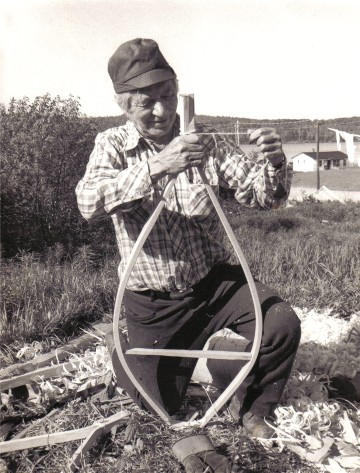 |
| Moise Flamand splitting a yellow birch log with wooden wedges for making snowshoe frames; Manouane, Quebec 1979; from ''Making the Attikamek Snowshoe ''; photo, Henri Vaillancourt | Moise Flamand tying the tails of a newly bent snowshoe frame, Manouane ,Quebec 1979 ; from ''Making the Attikamek Snowshoe'' ; photo Henri Vaillancourt |
![The start of weaving the toe of a 'square-toe' snowshoe. The weaving pattern is essentially the same in all parts of the snowshoe, but is modified to fit different configurations of space ; here it is modified to fill the wider square-toe section of the frame [ as compared to the more triangular tail section].From ''Making the Attikamek Snowshoe'', sketch Henri Vaillancourt](images/book-weavingoftoesketch.jpg) |
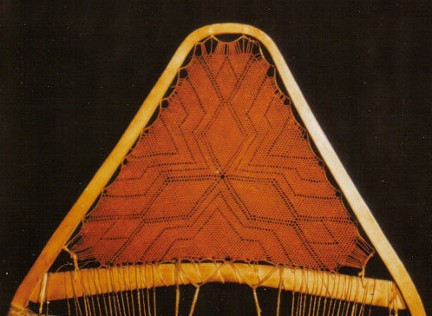 |
|
| The start of weaving the toe of a 'square-toe' snowshoe. The weaving pattern is essentially the same in all parts of the snowshoe, but is modified to fit different configurations of space ; here it is modified to fill the wider square-toe section of the frame [ as compared to the more triangular tail section].From ''Making the Attikamek Snowshoe'', sketch Henri Vaillancourt | An exceptionally finely woven snowshoe, circa pre-1926, McCord Museum collection, Montreal. The pattern is unusually complex, but might be typical of snowshoes made in earlier times: from ''Making the Attikamek Snowshoe'', photo Henri Vaillancourt |
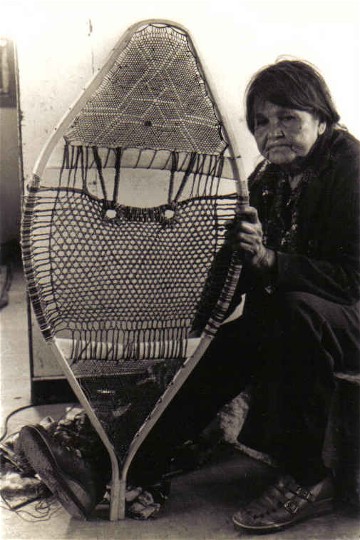 |
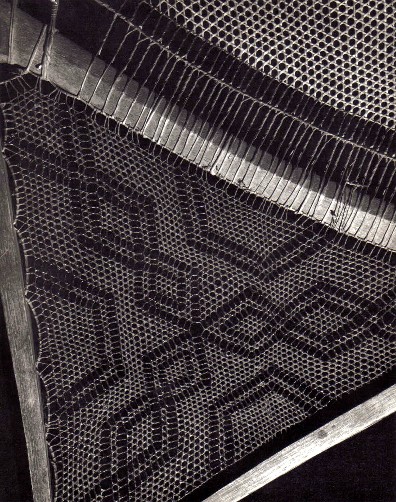 |
|
| Judith Quitich and a newly woven snowshoe with geometric patterns in the toe and tail sections ; Manouane , Quebec, 1979 ; from ''Making the Attikamek Snowshoe'' photo Henri Vaillancourt | The tail weave of an old pair of highly finished Attikamek snowshoes.The woven designs have been traced over with black paint to highlight them , a technique used by other tribes as well; often the woven designs are left unpainted.Note also the double space in the midsection weave at the tail crossbar , a technique peculiar to the Attikamek; from ''Making the Attikamek Snowshoe'', photo courtesy of the Lower Ft. Garry National Historic Park |
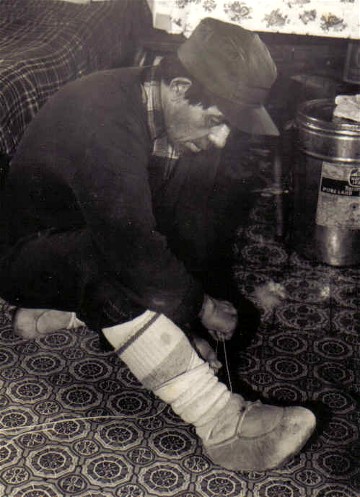 |
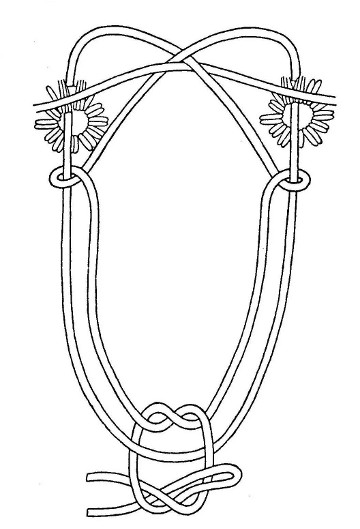 |
|
| Cree Indian lacing up a winter moccasin ; the strings are wound around the cloth top flaps to close them. The bottoms are made of moose or caribou skin. Warm and light , moccasins are the best footgear for use with snowshoes, allowing for a control of the snowshoe impossible with stiffer foot coverings ; Assinica Lake,Quebec 1980 ; from ''Making the Attikamek Snowshoe'' photo Henri Vaillancourt | The typical Attikamek snowshoe harness. Ordinarily made of tanned mooseskin, the harness is sometimes fashioned of lampwick, canvas strips, or cord. The same type of harness is used by the Algonquin, Ojibway and Cree Indians; from ''Making the Attikamek Snowshoe''. sketch Henri Vaillancourt |
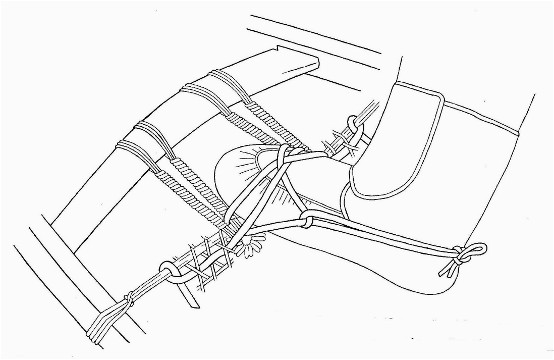 |
| The moccasined foot in place within the snowshoe harness ; with a simple twist of the foot , the snowshoes can be easily put on or taken off. The soft pliable leather or fabric straps , in combination with the soft leather moccasins, allow for a 'feel' and control of the snowshoe impossible with modern footgear and harnessing systems ; from''Making the Attikamek Snowshoe'', sketch Henri Vaillancourt |
[TOP]
For more information not included on this website
email
henri5@birchbarkcanoe.net
phone 603-878-3616
or write Henri Vaillancourt
PO Box 142
Greenville, New Hampshire, 03048
